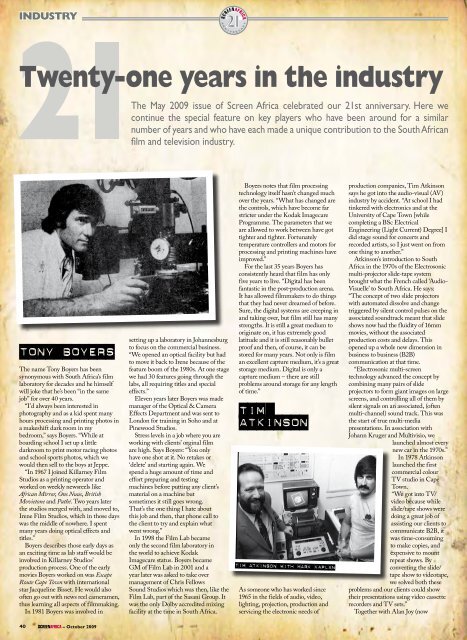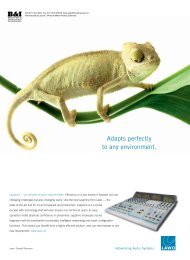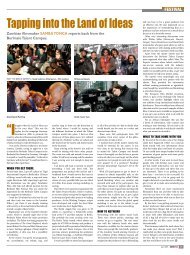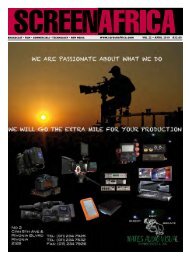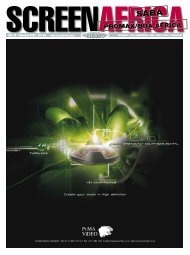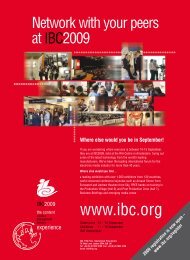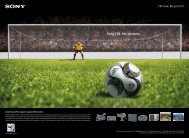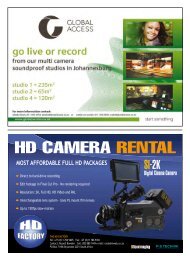Dowbload Part 3 - size: 2.7mb - Screen Africa
Dowbload Part 3 - size: 2.7mb - Screen Africa
Dowbload Part 3 - size: 2.7mb - Screen Africa
Create successful ePaper yourself
Turn your PDF publications into a flip-book with our unique Google optimized e-Paper software.
N<br />
R<br />
INDUSTRY<br />
CR<br />
A<br />
SCREENAFRICA<br />
Y<br />
N<br />
I<br />
V<br />
E<br />
R<br />
S<br />
A<br />
Twenty-one years in the industry<br />
The May 2009 issue of <strong>Screen</strong> <strong>Africa</strong> celebrated our 21st anniversary. Here we<br />
continue the special feature on key players who have been around for a similar<br />
number of years and who have each made a unique contribution to the South <strong>Africa</strong>n<br />
film and television industry.<br />
TONY BOYERS<br />
The name Tony Boyers has been<br />
synonymous with South <strong>Africa</strong>’s film<br />
laboratory for decades and he himself<br />
will joke that he’s been “in the same<br />
job” for over 40 years.<br />
“I’d always been interested in<br />
photography and as a kid spent many<br />
hours processing and printing photos in<br />
a makeshift dark room in my<br />
bedroom,” says Boyers. “While at<br />
boarding school I set up a little<br />
darkroom to print motor racing photos<br />
and school sports photos, which we<br />
would then sell to the boys at Jeppe.<br />
“In 1967 I joined Killarney Film<br />
Studios as a printing operator and<br />
worked on weekly newsreels like<br />
<strong>Africa</strong>n Mirror, Ons Nuus, British<br />
Movietone and Pathé. Two years later<br />
the studios merged with, and moved to,<br />
Irene Film Studios, which in those days<br />
was the middle of nowhere. I spent<br />
many years doing optical effects and<br />
titles.”<br />
Boyers describes those early days as<br />
an exciting time as lab staff would be<br />
involved in Killarney Studios’<br />
production process. One of the early<br />
movies Boyers worked on was Escape<br />
Route Cape Town with international<br />
star Jacqueline Bisset. He would also<br />
often go out with news reel cameramen,<br />
thus learning all aspects of filmmaking.<br />
In 1981 Boyers was involved in<br />
setting up a laboratory in Johannesburg<br />
to focus on the commercial business.<br />
“We opened an optical facility but had<br />
to move it back to Irene because of the<br />
feature boom of the 1980s. At one stage<br />
we had 30 features going through the<br />
labs, all requiring titles and special<br />
effects.”<br />
Eleven years later Boyers was made<br />
manager of the Optical & Camera<br />
Effects Department and was sent to<br />
London for training in Soho and at<br />
Pinewood Studios.<br />
Stress levels in a job where you are<br />
working with clients’ orginal film<br />
are high. Says Boyers: “You only<br />
have one shot at it. No retakes or<br />
‘delete’ and starting again. We<br />
spend a huge amount of time and<br />
effort preparing and testing<br />
machines before putting any client’s<br />
material on a machine but<br />
sometimes it still goes wrong.<br />
That’s the one thing I hate about<br />
this job and then, that phone call to<br />
the client to try and explain what<br />
went wrong.”<br />
In 1998 the Film Lab became<br />
only the second film laboratory in<br />
the world to achieve Kodak<br />
Imagecare status. Boyers became<br />
GM of Film Lab in 2001 and a<br />
year later was asked to take over<br />
management of Chris Fellows<br />
Sound Studios which was then, like the<br />
Film Lab, part of the Sasani Group. It<br />
was the only Dolby accredited mixing<br />
facility at the time in South <strong>Africa</strong>.<br />
Boyers notes that film processing<br />
technology itself hasn’t changed much<br />
over the years. “What has changed are<br />
the controls, which have become far<br />
stricter under the Kodak Imagecare<br />
Programme. The parameters that we<br />
are allowed to work between have got<br />
tighter and tighter. Fortunately<br />
temperature controllers and motors for<br />
processing and printing machines have<br />
improved.”<br />
For the last 35 years Boyers has<br />
consistently heard that film has only<br />
five years to live. “Digital has been<br />
fantastic in the post-production arena.<br />
It has allowed filmmakers to do things<br />
that they had never dreamed of before.<br />
Sure, the digital systems are creeping in<br />
and taking over, but film still has many<br />
strengths. It is still a great medium to<br />
originate on, it has extremely good<br />
latitude and it is still reasonably bullet<br />
proof and then, of course, it can be<br />
stored for many years. Not only is film<br />
an excellent capture medium, it’s a great<br />
storage medium. Digital is only a<br />
capture medium – there are still<br />
problems around storage for any length<br />
of time.”<br />
TIM<br />
ATKINSON<br />
Tim Atkinson with Mark Kaplan<br />
As someone who has worked since<br />
1965 in the fields of audio, video,<br />
lighting, projection, production and<br />
servicing the electronic needs of<br />
production companies, Tim Atkinson<br />
says he got into the audio-visual (AV)<br />
industry by accident. “At school I had<br />
tinkered with electronics and at the<br />
University of Cape Town [while<br />
completing a BSc Electrical<br />
Engineering (Light Current) Degree] I<br />
did stage sound for concerts and<br />
recorded artists, so I just went on from<br />
one thing to another.”<br />
Atkinson’s introduction to South<br />
<strong>Africa</strong> in the 1970s of the Electrosonic<br />
multi-projector slide-tape system<br />
brought what the French called ‘Audio-<br />
Visuelle’ to South <strong>Africa</strong>. He says:<br />
“The concept of two slide projectors<br />
with automated dissolve and change<br />
triggered by silent control pulses on the<br />
associated soundtrack meant that slide<br />
shows now had the fluidity of 16mm<br />
movies, without the associated<br />
production costs and delays. This<br />
opened up a whole new dimension in<br />
business to business (B2B)<br />
communication at that time.<br />
“Electrosonic multi-screen<br />
technology advanced the concept by<br />
combining many pairs of slide<br />
projectors to form giant images on large<br />
screens, and controlling all of them by<br />
silent signals on an associated, (often<br />
multi-channel) sound track. This was<br />
the start of true multi-media<br />
presentations. In association with<br />
Johann Kruger and Multivisio, we<br />
launched almost every<br />
new car in the 1970s.”<br />
In 1978 Atkinson<br />
launched the first<br />
commercial colour<br />
TV studio in Cape<br />
Town.<br />
“We got into TV/<br />
video because while<br />
slide/tape shows were<br />
doing a great job of<br />
assisting our clients to<br />
communicate B2B, it<br />
was time-consuming<br />
to make copies, and<br />
expensive to mount<br />
repeat shows. By<br />
converting the slide/<br />
tape show to videotape,<br />
we solved both these<br />
problems and our clients could show<br />
their presentations using video cassette<br />
recorders and TV sets.”<br />
Together with Alan Joy (now<br />
40<br />
SCREENAFRICA – October 2009


